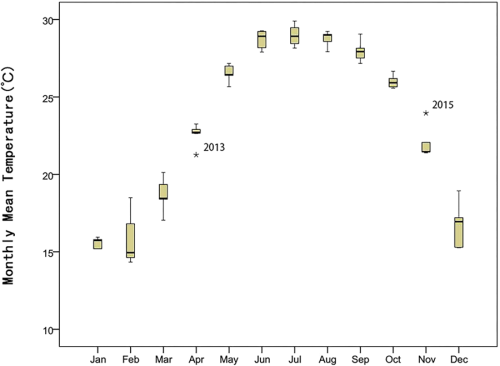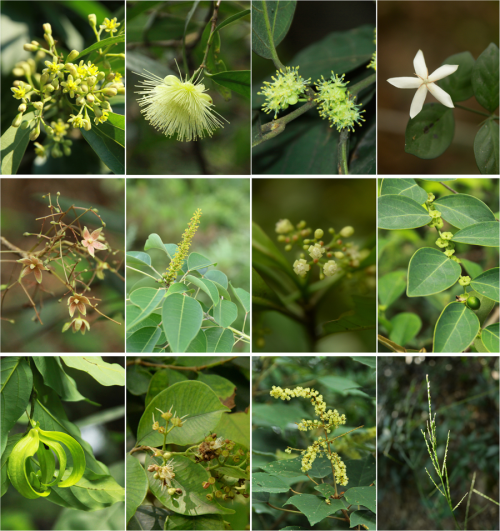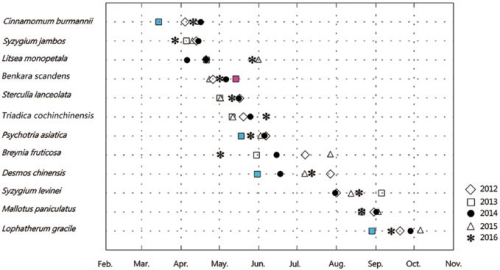Rapid Shifts of Peak Flowering Phenology in 12 Species under the Efects of Extreme Climate Events in Macao
Plant phenology is the most sensitive and accurate indicator of environmental change, including plant germination, leaf buding, flowering, etc. Through the monthly phenological observation of plants, the arrival time, duration and annual change of each growth and development period were recorded to understand the relationship with the external environment climate, especially the. As an indicator to analyze local climate change patterns and to indicate local natural seasonal changes, plant phenology can not only provide basic information for local vegetation conservation, but also evaluate the impact of climate change on plants.
From October 2011, Conservation of Species Diversity Research Group of SCBG cooperated with Civil and Municipal Affairs Bureau of Macao Special Administrative Region of Macao to operate the project wild plant phenology and its response to climate change. We set up 3 permanent sample plots in 3 representative plant communities. After 7 years of monitoring, a large amount of phenological data has been accumulated, and most plant phenological regulations in the sample area have been acquired.
In the present study, Zhang Jianhao, an undergraduate student, and Xing Fuwu and yi qifei used phenological records from a manual monitoring program to characterize the flowering phenology of 12 species in Guia Hill, Macao. The mean peak flowering dates (PFDs) of these species ranged from March to September, 41.7% of which occurred in May. The earliest or latest PFDs of nine species occurred in 2013, a year with extremely heavy rain events in early spring. In addition, we found that, in the 5-year period, the monthly mean temperature or monthly precipitation in two periods, specifically 1) during November to December of the previous year and 2) during 0–2 months before the PFDs of each species, were significantly correlated with the PFD of eight species. The result showed that, even though complex species-specific responses to the characteristics of climate widely exist, most species in the present study responded to shifts in climate shifts in these two periods. In addition, some species were extraordinarily sensitive to extreme climate events. Precipitation was more effective in altering flowering date than temperature, especially among the late-flowering species in Guia Hill, Macao.
This study were published in SCI Scientific Report (IF: 4.12) “Rapid Shifts of Peak Flowering Phenology in 12 Species under the Effects of Extreme Climate Events in Macao”. The research was funded by the international cooperation (Macau) project. Zhang Jianhao is the first author of this paper, and Yi Qifei is the corresponding author.
Figure 2. Boxplot of Monthly Precipitation (MP) of each month in 2012–2016. * indicates the deviation was significant. The MP of January 2016 and February 2015 was significantly high. The MP of February 2013 was significantly low. Variation amplitudes of MP in March-August were obviously larger than other months.

Figure 3. Boxplot of Monthly Mean Temperature (MMT) of each month in 2012–2016. * indicates the deviation was significant. MMT in April 2013 was significantly low. MMT in November 2015 was significantly high. According to the correlation analysis of present study, the MMT in November 2015 mainly affected the peak flowering dates in 2016. The amplitudes of variation in MMT in February and December are larger than other months.

Figure 4. Twelve species in Guia Hill, Macao included in this study. From the top-left to bottom-right: Cinnamomum burmannii, Syzygium jambos, Litsea monopetala, Fagerlindia scandens, Sterculia lanceolata, Sapium discolor, Psychotria asiatica, Breynia fruticosa, Desmos chinensis, Syzygium levinei, Mallotus paniculatus, Lophatherum gracile.
File Download:

